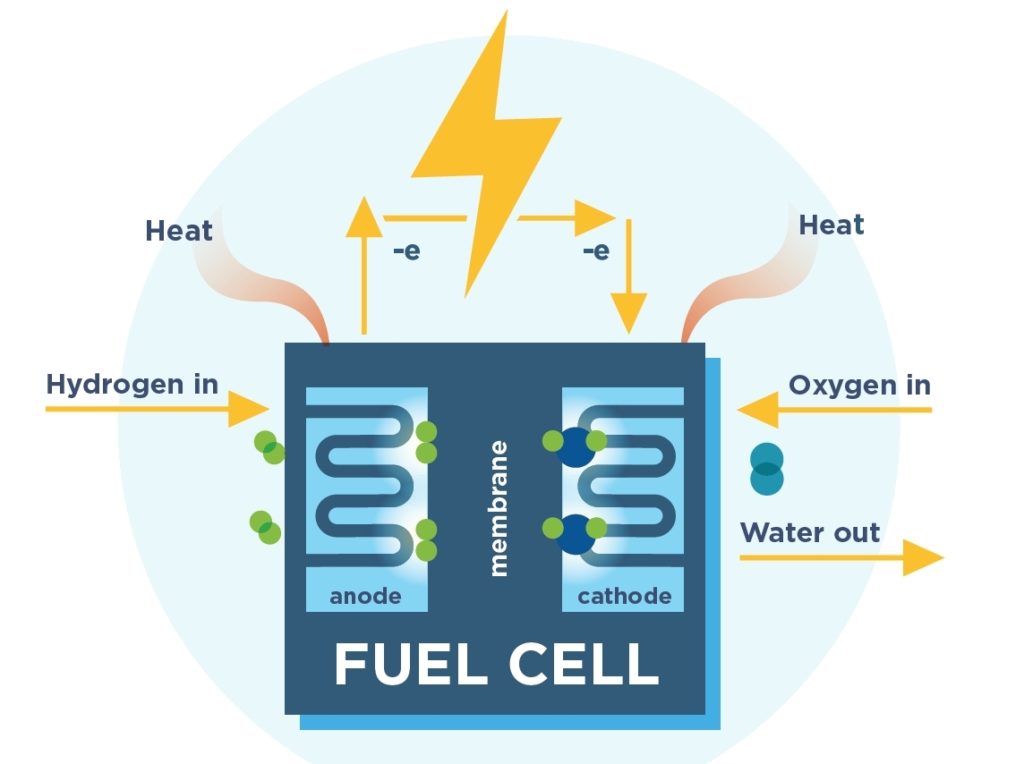What is a fuel cell?
A fuel cell is ”a device that converts chemical potential energy into electrical energy”. More specifically, it is an electrochemical cell that converts the chemical energy of a fuel and an oxidizing agent into electricity through a pair of redox reactions. Unlike a battery, it does not store chemical or electrical energy; a fuel cell allows electrical energy to be extracted directly from a chemical reaction. When referring to fuel cells, the most commonly mentioned type is the PEM (Proton Exchange Membrane) cell. This cell uses hydrogen gas (H2) and oxygen gas (O2) as fuel to make electricity and water vapor. Oxygen is readily available in the atmosphere and hydrogen is gathered through the process of electrolysis of water.

PEM Cells
A PEM Cell is comprised of 4 Basic parts:
- Anode
- Cathode
- Electrolyte
- Catalyst
Hydrogen fuel is processed at the anode where electrons are separated from protons. The protons pass through the membrane to the cathode side of the cell while the electrons travel in an external circuit, generating the electrical output of the cell. On the cathode side, the electrode combines the protons and electrons with oxygen to produce water, which is expelled as the only waste product.
The PEM fuel cell uses a water-based, acidic polymer membrane as its electrolyte, with platinum-based electrodes. PEMFC cells operate at relatively low temperatures (below 100 degrees Celsius) and have to use pure hydrogen for the reaction. These cells are currently the leading technology for commercial vehicles and are a promising future for renewable energy.


Nikola Motors
Nikola Motors is an American hybrid truck design and manufacture company, but functions as an energy and Powersports company as well. The company is valued at $27 billion and is worth more than Ford and Fiat-Chrysler despite making $0 in revenue. Though the growth of the company is highly unstable, Nikola displays the possibility of hydrogen fuel cell vehicles entering the market for commercial vehicles.

In order to successfully create an ecosystem for their fuel car vehicles, Nikola motors plan to create stations across the country/world, much like the Tesla supercharger network. Ideally, using hydrogen fuel will produce zero emissions, weigh much less than electric/conventional gas vehicles, and longer distances than battery-powered vehicles. However, one of the primary concerns faced by Nikola is the cost of these stations. For comparison, one of Tesla’s stations costs around $250,000 while it would cost around $15 million to $20 million per station. Without a sufficient network of stations, it would be nearly impossible to enter the market place and compete against motor vehicle juggernauts like Tesla.


Commercial Viability
As mentioned above, the Nikola company is displaying rapid growth over the past months and is easily surpassing many competitors. Hydrogen fuel cells have been powering space shuttles since the early 1960s. NASA has funded more than 200 research contracts exploring fuel cell technology, bringing it to a level now viable for the private sector. However, the NKLA stock has shown a decreasing trend and illustrates the large inflation that it was experiencing in its early growth period. The main criticism that hydrogen fuel cells face is its inferiority when compared to electric charging.

The graph above shows the efficiency of different fuel types for commercial vehicles. The problem with hydrogen fuel is that there are many intermediate processes that significantly cut down on fuel efficiency. Electric cars only have to transmit the electricity from the grid to the batteries/tanks and then to the vehicle. On the other hand, hydrogen fuel cells need to receive renewable energy, perform electrolysis, store the hydrogen, transport the hydrogen fuel to the stations, and then power the vehicles. These additional steps not only cut down on efficiency but also significantly increase the costs. Many of these technologies cannot be incorporated into a private home, and so the fuel station network is integral to the success of hydrogen fuel vehicles. The problem arises from the fact that Nikola owns many of the patents for the fuel cells and stations, which limit the production of these stations, thus limiting the number of vehicles that can be used. From these myriads of factors, it is too early to claim that hydrogen fuel can be properly integrated into the modern consumer’s life, and the foundations must be solidified before the expansion of this industry can continue.
References
[1] Tai, Humayun. (2019). “Decarbonizing the grid: Stabilizing the future of renewables”. McKinsey & Company. https://www.mckinsey.com/business-functions/sustainability/our-insights/sustainability-blog/decarbonizing-the-grid-stabilizing-the-future-of-renewables# Last Accessed: 12 June 2020.
[2] Parkinson, Giles. (2018). “Hydrogen fuel cell cars have three times emissions of battery EVs – UQ study”. The Driven.https://thedriven.io/2018/11/15/hydrogen-fuel-cell-cars-have-three-times-emissions-of-battery-evs-uq-study/#:~:text=When%20the%20grid%20is%20decarbonised,be%20fuelled%20by%20renewable%20energy Last Accessed: 12 June 2020.
[3] Aruliah, Arasan. (2019). “electrolysis”. energypost.eu. https://energypost.eu/u-s-nuclear-plants-to-produce-carbon-free-hydrogen/electrolysis/ Last Accessed: 12 June 2020.
[4] (2015). “The Hydrogen-Fuel cell will revolutionize the economy of the world”. Hydrogen Fuel News. http://www.hydrogenfuelnews.com/the-hydrogen-fuel-cell-will-revolutionize-the-economy-of-the-world/8522370/ Last Accessed: 12 June 2020.
[5] “Phosphoric Acid Fuel Cell”. FuelCellsWorks. https://fuelcellsworks.com/knowledge/technologies/pafc/ Last Accessed: 12 June 2020.
[6] Pinza, Marco. (2020). “Nikola goes forward to getting its fuel cell trucks on the road”. Australia HeavyQuip Journal. https://www.australiahqj.com/2020/07/21/nikola-motor-company-nasdaqnkla-foresees-considerable-shifts-in-the-transportation-sector/ Last Accessed: 12 June 2020.
[7] “Supercharger”. Tesla. https://www.tesla.com/supercharger Last Accessed: 12 June 2020.
[8] Bannon, Eoin. (2020). “Wednesday’s EU hydrogen strategy needs to prioritise hard-to-decarbonise transport modes”. Transport & Environment. https://www.transportenvironment.org/press/wednesday%E2%80%99s-eu-hydrogen-strategy-needs-prioritise-hard-decarbonise-transport-modes Last Accessed: 6 September 2020.
(Thumbnail image source) [10] (2019). “Fuel Cell & Hydrogen Energy Basics”. Fuel Cell & Hydrogen Energy Association. http://www.fchea.org/h2-day-2019-events-activities/2019/8/1/fuel-cell-amp-hydrogen-energy-basics Last Accessed: 6 September 2020.
